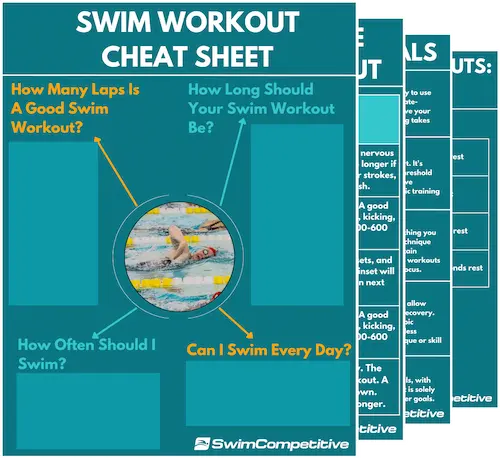Resistance bands are a dryland tool that most swimmers are familiar with and that most coaches love to incorporate into dryland training routines. Resistance bands serve as a cost-effective and easy to use tool for swimmers, helping to build strength, improve performance in the water, and even prevent injuries.
The number of exercises that you can perform with resistance bands is almost endless, allowing you to target and train large muscle groups frequently used in swimming.
Not only that but you’ll also be able to mimic your stroke to develop added power and refine your technique for when it’s time to hop in the pool to swim.
Resistance bands allow swimmers from all levels and ages to safely and effectively get in a full-body workout that will enhance their performance in the water. These bands come in many different resistance levels and you can add various attachments to some to further increase their versatility.
So does that sound good to you? Great! Because in today’s article we’ll be taking a look at 10 of the most useful resistance band exercises for swimmers that you can use to become a stronger and faster swimmer this season and the seasons to come.
Need some resistance bands? I recommend the FINIS Dryland cords:
Why Use Resistance Bands for Swimmers? The Benefits
I know, I just briefly covered some of the benefits of resistance bands for swimmers, but before we start, let’s have a deeper look into some of these benefits as well as others to see how resistance bands can help you to become a better swimmer.
1. Improved Swimming Performance
Using resistance bands can be greatly beneficial in building added power, strength, muscle, and core stability outside of the water. You’ll also have the opportunity to improve your explosiveness and even flexibility while also refining and strengthening your swimming technique with swim-specific resistance band movements.
All of this can greatly improve your swimming performance in the pool and will allow you to swim faster than before, helping you to crush that PB, win that gold medal, or even snatch up that important qualifying time that you’ve been dreaming about.
2. Train Anywhere, Anytime
Can’t hit the pool today? Out on holiday or traveling? Pool closed? Don’t worry! You don’t have to miss out on training since you can just whip out your resistance band set and get on with it.
Resistance bands enable swimmers to be able to train wherever and whenever, which is great since we don’t have to miss out on training or feel like we are being placed at a disadvantage to our competition.
3. Mix Things Up and Keep Your Training Interesting
Going to the pool day in and day out can definitely get a bit boring from time to time. Luckily, it doesn’t have to be this way. By using a resistance band dryland training program you can mix things up a bit and stay engaged in your workouts and training.
You can choose to take a day off from swimming altogether and just do resistance band dryland training or you can simply do some resistance band training before or after swimming practice just to mix things up for a change.
4. Improve and Refine Your Swimming Stroke Technique
There are an absolute ton of resistance band exercises for swimmers out there. And part of that includes mimicking your swimming stroke. With resistance bands, you are essentially able to copy almost any swimming stroke and train and work on that stroke on land using higher resistance which will allow you to become stronger for next time you swim that same stroke.
You’ll also be able to practice and work on different technical aspects of swimming that you may struggle to figure out in the water, enabling you to improve your swimming technique without actually being in the pool.
5. Great Warm-Up and Injury Prevention Tool
Despite being a great tool to improve our performance and become stronger and faster swimmers, resistance bands can also be used as a warm-up and injury prevention tool.
By warming up your muscles before hopping in the pool you are far less likely to sustain an injury. You’ll also be able to train and strengthen weaker muscles that may be prone to injury as well as engaging muscles in a different way to avoid overuse injuries in the pool.
Some good warm-up and injury prevention resistance band exercises include-
- External shoulder rotation to 90°
- External outward shoulder rotation
- Above the head flaps
- Shoulder retractions
Resistance Band Exercises for Swimmers: 10 Must-Do’s
In this article, we will be focusing on strength orientated resistance band exercises for swimmers, instead of swim specific ones since most swimmers already know and use these, I thought it’d be more beneficial to give you a list of exercises that you can use to strengthen and develop those important muscle groups for swimming than to tell you about ones you already know.
Here are some great resistance band exercises for swimmers to develop strength and power-
- Seated lat pull-downs.
- Resistance band alternative shoulder press.
- Upright rows.
- Resistance band chest press.
- Squats.
- Lateral raises.
- Resistance band kneeling ab crunch.
- Tricep kickbacks.
- Bicep curls.
- Glute kickbacks.
1. Resistance Band Seated Lat Pull-Down
The lats are some of the most important muscles in swimming and are also one of the easiest ways to identify if someone is a swimmer or not since pretty much all swimmers have strongly developed lats.
Training and strengthening your lats can help to develop an absolutely killer pull on all strokes and will help you to swim faster. The lat pull-down is one of the most effective exercises for training these muscles and fortunately we can perform it using resistance bands.
To perform the resistance band seated lat pulldown you are going to have to anchor your resistance band somewhere in an overhead position in front of you. It shouldn’t be too high, but neither too low, find a height that works well for you.
Once your band is anchored take a seat about 2-3 feet away from the anchored position while holding the resistance bands so that your arms are extended in front of you. (You are facing the anchored position).
Then, tighten your back and core and pull back on the bands so that your shoulder blades get squeezed together. Once there, release and slowly go back into the starting position, thereafter, you will repeat that movement again. Repeat for 3-4 sets of 8-12 reps.
If you are looking for another excellent lat exercise, then you should definitely consider pull-ups. To learn more about this exercise, check out my article- why every swimmer should do pull-ups for an in-depth overview, benefits, technique, and progressions.
2. Resistance Band Alternating Shoulder Press
The shoulders are highly important muscle groups in swimming and are required to have a powerful pull and rigid streamline position. And what better way to train them than using the shoulder press? (also known as the overhead press).
In the weight room, elite-level swimmers frequently perform this exercise using a barbell or dumbbells. We are, however, going to be performing it using resistance bands.
To perform this exercise there are 3 steps that we want to follow to ensure proper technique-
First you want to place the resistance band underneath one foot, positioned slightly in front of you, while your other foot is placed slightly behind you so that you have a solid stance.
Then bring your arms up so that your hands are at shoulder height with the resistance band running through underneath your arms and coming over at the opposite ends where you’ll hold the band.
After then press one arm up into the air until your arms are fully extended and your shoulder locks out at the top. Then lower the extended arm and bring up your opposite arms so that you form an alternating movement.
You can also perform this exercise with simulations movements if you prefer that.
Perform 3-4 sets of 6-12 reps depending on the resistance of your band.
3. Resistance Band Upright Rows
The resistance band upright row is a great, challenging, and simple to perform exercise that targets the deltoids muscles in your shoulders, the tricep muscles in your arms, and the trapezius and lat muscles in your back.
All of these muscles are important for developing a killer pull and can help you to swim much faster if trained and strengthened properly.
To perform the resistance band upright row place your resistance band so that it runs underneath your feet. Then take the handles and cross them so that you form an X with the resistance bands.
After that bring the resistance band up until shoulder height by using your arms and back muscles. Keep in mind, you should stay in an upright position and your back shouldn’t bend at all.
Once you’ve brought it up to shoulder height, lower them back down to the starting position, which should be around hip-height.
4. Resistance Band Chest Press
The chest muscles play an important role in both breaststroke and butterfly swimming and are required to develop a powerful sweep of the arms during the pulling phase. The chest press is a great exercise to strengthen the chest, tricep, and shoulder muscles and is similar to the widely used bench press exercise that many athletes perform in the weight room.
To perform the resistance band chest press you are once again going to need to anchor your resistance band somewhere overhead, but this time you’ll be facing away from the anchored position.
Place one foot in front of the other and slightly lean forward while holding the handles. Then push forward until your arms are fully extended in front of you. Make sure to keep your back rigid and to feel your chest muscles contract as your push forward.
Then slowly reverse the movement and return to the starting position. Repeat for 3-4 sets of 8-12 reps depending on the resistance of your band.
Do You Want to Make Every Lap Count?
Stop wasting your time in the pool feeling lost and doing directionless swim workouts, and start training effectively! Our ebook contains 97 structured and goal-orientated swim workouts to help you become a better, faster, and fitter swimmer. Whether you’re a complete beginner or a seasoned pro, there are a multitude of workouts for every type of swimmer.
5. Resistance Band Squats
The squat is one of the best all around leg exercises out there. It targets and trains pretty much every large muscle group in your legs with the primary activators being the glutes, quadriceps, and hamstrings.
Strong legs will ensure that you have a powerful kick in the water and will also help you to develop fast and strong dives, push-offs, and underwaters which all play a critical role in swimming as fast as possible and claiming a new best time or podium position.
There are many variations of squats including the barbell back squat, barbell front squat, goblet squats, split squats and so on. Not-surprisingly we also have a resistance band variation of the squat that you can use to train your legs.
To perform the resistance band squat place the bands underneath your feet while holding the handles. Then bring your arms up so that the resistance bands are behind your arms. Your arms should be bent when holding the resistance band and it should look almost as if you were about to do an overhead press.
Once you are in this position, squat down until your butt is just below knee-height. Then extend up into the starting position again. Make sure to distribute the weight on your feet evenly and not to squat on your toes.
Repeat for 3-4 sets of about 6-12 reps depending on how heavy the resistance you are using is.
Need resistance bands? Check out one of my favorite dryland resistance cord sets from FINIS:
6. Resistance Band Lateral Pulls
As mentioned earlier, the lats are some of the most important muscles in swimming and strengthening them will help you to build a strong pull in the water. The resistance band lateral pull is quite a challenging exercise and will develop not only your lats, but also a lot of other big and small muscles in your back.
To perform this exercise anchor your resistance band directly in front of you at about chest height or just below chest height. Then grab your bands and walk back about 3-4 feet and slightly bend your knees while facing the anchored position.
Make sure to keep your back straight and rigid when performing this exercise. Then pull back on your resistance band so that your arms extend outward, and your shoulder blades get pushed together. From a front-facing perspective you should look like a T, but with your arms on the same height as your shoulders.
After that, slowly reverse the movement and go back into the starting position. Repeat this exercise for 3-4 sets of 6-10 reps depending on the resistance of your bands.s
7. Resistance Band Kneeling Ab Crunch
As swimmers, we all know how important a strong core is. A lot of us properly do regular core training and know a bunch of good core exercises. But have you ever thought of using a resistance band to train your core?
The resistance band kneeling ab crunch is one of the most effective exercises for developing a stronger core and will deliver a serious burn.
To perform it anchor your resistance band in an overhead position. Then grab the handles, walk back about 1-2 feet and go onto your knees. The handles should be held tightly in front of you, against your shoulders, and you should be facing the anchored position.
Then pull down so that your abdominal muscles contract and your face gets lowered to the ground towards your knees. Once fully contracted, reverse the movement and go back into the starting position.
Repeat this for 3-4 sets of 15-20 reps.
If you’d like some more core exercises, I recommend checking out my article on the 10 best core exercises for swimmers. It’s quite a popular article, and I think that it can benefit you and your swimming a lot.
8. Resistance Band Tricep Kickbacks
The resistance band tricep kickback is an isolation exercise targeting the large tricep muscles in your arms. These muscles play an important role in swimming and will help you to develop a powerful and explosive pull, as well as a strong push from the blocks at the start of a race.
There are many variations of the resistance band tricep kickback. It can be performed using dumbells or by using a tricep kickback machine in the gym. We, however, will obviously be performing it using a resistance band.
To start, anchor your resistance band in an overhead position or somewhere just above chest height. Then grab the handles and walk back about 1-2 feet from the anchored position while facing it.
Once there, slightly bend your knees, and lean slightly forward while keeping your back straight and rigid and your core braced. After that, push the resistance band back so that your arms extend until they are locked out at the back and your tricep is fully contracted.
Then slowly reverse the movement back into the starting position and repeat for 3-4 sets of 8-12 reps depending on the resistance of your band.
9. Resistance Band Bicep Curls
Similar to the resistance band tricep kickback, the resistance band bicep curl is an isolation exercise that targets the bicep muscles in your arms. The biceps aren’t the most important muscles for swimming, but they are used in pretty much all strokes, and strengthening them will only help you to build a stronger pull which will help you to swim faster.
Similar to a lot of the exercises we have discussed so far, the bicep curl can be done in many variations- standing dumbbell curls, barbell curls, preacher curls, etc. And of course it can be performed with resistance bands as well.
To perform the resistance band bicep curl, place the resistance band so that the bottom is running underneath your feet and the handles are being held firmly. Then simply curl the band up until you have fully contracted the bicep muscle. Once there, release and slowly lower the band back until your arms are fully locked out again.
As you become stronger you can use heavier resistance bands or you can connect 2 bands to the handles at once to receive the resistance of both. Perform about 3-4 sets of 10-12 reps of this exercise.
10. Resistance Band Glute Kickbacks
As we all know, the legs have some of the largest muscles in the body and strengthening them will greatly benefit your swimming by developing a stronger kick. The resistance band glute kickback is a great exercise that isn’t only going to strengthen the glute and hamstring muscles in your legs, but also your lower back and will develop core stability.
To perform this exercise anchor your resistance band in a lower position, somewhere at about knee height or even a bit lower. Then go onto your knees directly in front of the anchored position and pull the band through to anchor it on your one foot with it running underneath your body in between your arms.
Once it is anchored stabilize yourself using your arms and opposite leg and then push back with your foot so that you feel a contraction in your hamstring and glute muscles as you fully extend your leg.
Once fully extended, reverse the movement and return to the starting position, thereafter you repeat the movement for 3-4 sets of 10-15 reps.
Need resistance bands? Check out one of my favorite dryland resistance cord sets from FINIS:
If you’re looking for some more exercises, I have another article covering over 100 dryland exercises for swimmers.
Improve Your Performance with Resistance Band Exercises for Swimmers
Resistance bands are a great training tool for swimmers that enables you to do useful compound and isolation exercises right there next on pool deck or wherever you are. It enables swimmers to strengthen muscles without the expense of paying for a gym membership and can improve swimming performance for swimmers of all ages.
That said, I hope that you found these exercises useful and that you’ll incorporate them into your training routine. Remember, they can also be great to do before swimming since they’ll activate the muscles and get them ready to perform.






